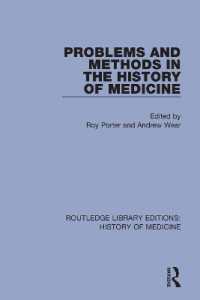- ホーム
- > 洋書
- > 英文書
- > Science / Mathematics
Full Description
In an era of rapid innovation and with a focus on sustainability, Chemical Engineering Essentials provides a definitive guide to mastering the discipline. Divided into two volumes, this series offers a seamless blend of foundational knowledge and advanced applications to address the evolving needs of academia and industry.
Volume 1 lays a strong foundation with topics such as material and energy balances, thermodynamics, phase equilibrium, fluid mechanics, transport phenomena, and essential separation processes such as distillation and membrane technologies.
This volume builds on these principles, delving into reaction engineering, reactor modeling with MATLAB and ASPEN PLUS, material properties, process intensification and nanotechnology. It also addresses critical global challenges, emphasizing green chemistry, waste minimization, resource recovery, and workplace safety.
Together, these volumes provide a holistic understanding of chemical engineering, equipping readers with the tools to innovate and lead in a dynamic and sustainable future.
Contents
Preface xiii
Raj Kumar ARYA, George D. VERROS and J. Paulo DAVIM
Part 1. Reaction Engineering 1
Chapter 1. Compaction, Compression and Consolidation in Pharmaceutical Industries 3
Neha DHIMAN and Girish GUPTA
1.1. Introduction to compression, compaction and consolidation 3
1.2. Definition and importance in pharmaceutical manufacturing 4
1.3. Powder properties and their characterization 7
1.4. Powdered characterization techniques 12
1.5. Tablet compression, compaction process and consolidation mechanisms 15
1.6. Tablet properties and quality control 19
1.7. Tablet manufacturing challenges 23
1.8. Compaction data analysis 25
1.9. Conclusion 28
1.10. References 28
Chapter 2. Reactive Chromatography: A Concept of Multifunctional Reactors 31
Praveen Kumar GHODKE, Sudip DAS and Rohidas BHOI
2.1. Introduction 31
2.2. Concept of multifunctional reactor 32
2.3. Reactive distillation 32
2.4. Reactive chromatography 33
2.5. Types of chromatographic reactors 34
2.6. Comparative discussion 41
2.7. Applications of chromatographic reactors 41
2.8. Mathematical modeling of chromatographic reactors 44
2.9. Mathematical modeling of FBCRs 44
2.10. Equilibrium-based continuous models 46
2.11. General rate model and simplified versions 46
2.12. Phase distribution 46
2.13. Model parameters 51
2.14. Adsorption equilibrium isotherms 51
2.15. Challenges and future prospect of chromatographic reactors 57
2.16. References 58
Chapter 3. Mathematical Modeling of a Batch Reactor and a Non-Isothermal CSTR with Their Respective Simulation Using MATLAB and ASPEN PLUS 63
Karthikeyan C., Praveen Kumar V., Preetha V. and Faheem ARAKKAL
3.1. Introduction 63
3.2. Modeling of a batch reactor 64
3.4. Conclusion 74
3.5. References 75
Part 2. Material Properties and Advanced Applications 79
Chapter 4. Properties of Materials and Selection Criteria 81
Dharmesh SUR, Abhishek GUPTA, Swati DUBEY and Avanish KUMAR
4.1. Introduction 81
4.2. Mechanical properties 83
4.3. Chemical properties 88
4.4. Other significant properties 91
4.5. Criteria for material selection with design consideration 94
4.6. References 106
Chapter 5. Hydrogen Production Pathways and Role of Catalysts 109
Anjali BAUDH, Sweta SHARMA and Rajesh Kumar UPADHYAY
5.1. Introduction 109
5.2. Hydrogen production mechanisms 110
5.3. Renewable production methods 117
5.4. Conventional and membrane reformers 121
5.5. Catalysts for hydrogen production technologies 122
5.6. Conclusion and future prospects 126
5.7. References 127
Chapter 6. Maximizing Vinyl Chloride Production: An ASPEN PLUS Simulation Approach 131
Edwin Varghese THOMAS, Selva KUMAR RAJA K., Karthikeyan C., Muthamizhi K. and Akhila HARIHARAN
6.1. Introduction 131
6.2. Methodology 135
6.3. Results and discussion 137
6.4. Energy used 140
6.5. Conclusion 141
6.6. References 141
Chapter 7. Process Intensification and Advanced Materials 143
Madhura A. BODKHE
7.1. Introduction 143
7.2. Process intensification technologies 146
7.3. Integration of process intensification and advanced materials 153
7.4. Conclusion and future prospects 165
7.5. References 167
Chapter 8. Nanotechnology in Chemical Engineering 173
Nandlal PINGUA, Avinash CHANDRA, Arvind K. GAUTAM, Raj Kumar ARYA and Akash KUMAR
8.1. Introduction to nanotechnology 174
8.2. Role of nanotechnology in chemical engineering 174
8.3. Emerging trends in nanotechnology-based chemical engineering 177
8.4. Challenges and solutions in nanotechnology for chemical engineers 179
8.5. Impact of nanotechnology on the future of chemical engineering 181
8.6. Case studies on the application of nanotechnology in chemical engineering 184
8.7. Future prospects of nanotechnology in chemical engineering 192
8.8. Conclusion 196
8.9. References 199
Part 3. Sustainability and Safety 205
Chapter 9. Green Chemistry and Sustainable Processes 207
Amit PARASHAR, Anurag TEWARI, Prahalad PRASAD PAROHA, Shikha GOVIL, Rajeev Kumar SINGH, Shailendra BADAL and Pastor ARGULLES
9.1. Introduction 208
9.2. The principles of green chemistry 209
9.3. Applications of green chemistry 218
9.4. Challenges and barriers 223
9.5. Sustainable processes 225
9.6. Case study: green chemistry in the textile industry 226
9.7. Conclusion 228
9.8. Acknowledgments 229
9.9. References 229
Chapter 10. Waste Minimization and Resource Recovery 235
Swati DUBEY, Avanish KUMAR, Abhishek GUPTA and Dharmesh SUR
10.1. Introduction 235
10.2. Types of wastes and various waste minimization techniques 237
10.3. Advantages of waste minimization 240
10.4. Process enhancement through waste minimization in chemical engineering 240
10.5. Resource recovery as an efficient way to minimize waste 241
10.6. Sustaining waste minimization 243
10.7. References 244
Chapter 11. Safety Management: Hazard Identification and Risk Assessment at the Workplace 247
Sushama AGARWALLA, Sunil Kumar SINGH, Mohammed Adil IBRAHIM and Suhanya DURAISWAMY
11.1. Introduction 247
11.2. Hazard identification 251
11.3. Process hazards checklist 252
11.4. Hazard survey 255
11.5. Hazards and operability (HAZOP) studies 264
11.6. Safety review 265
11.7. Other methods 267
11.8. Risk assessment 268
11.9. Quantitative risk analysis 269
11.10. Conclusion 272
11.11. References 272
List of Authors 277
Index 281
Summary of Volume 1 285








